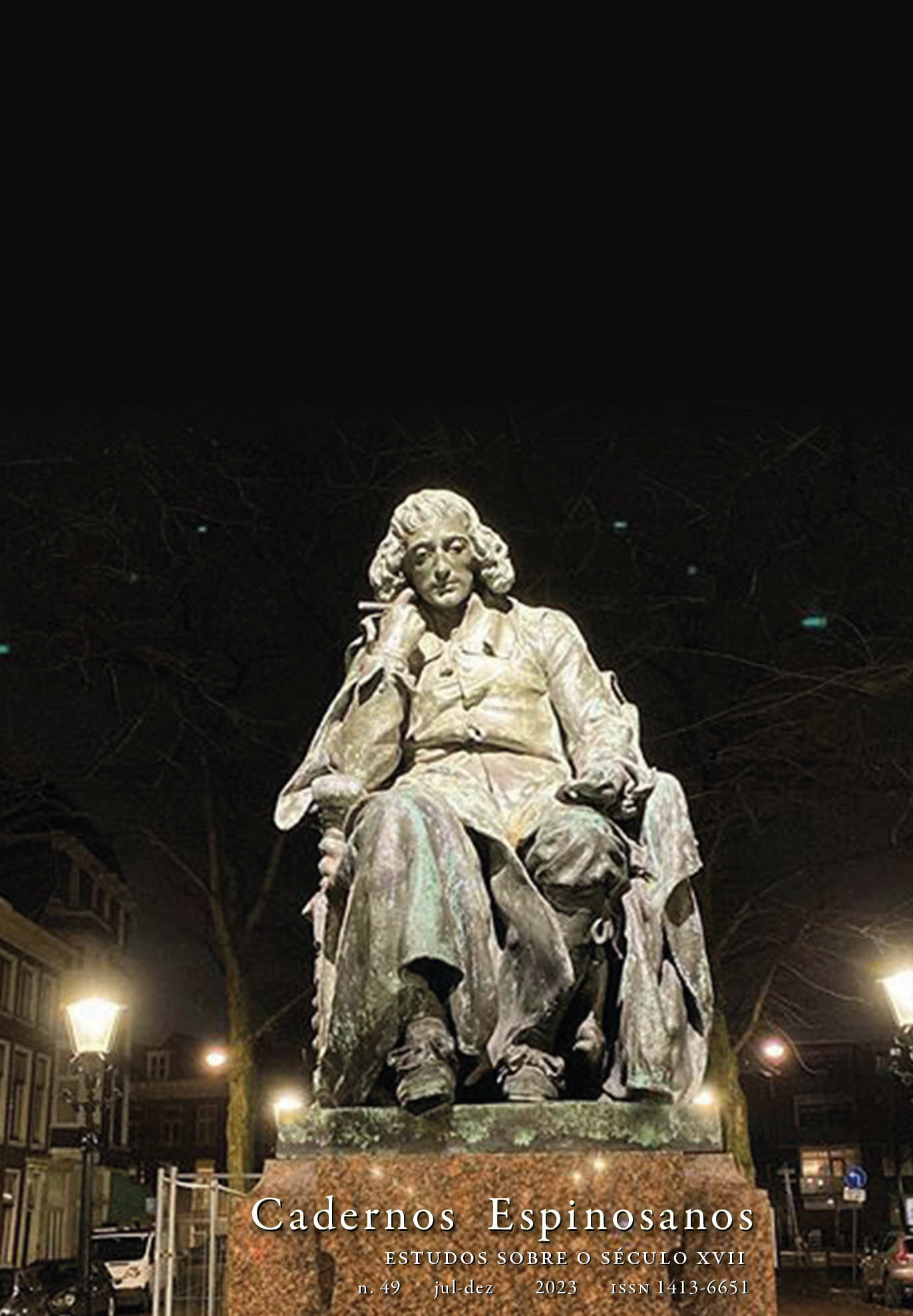Spinoza’s self-imagining machine
DOI:
https://doi.org/10.11606/issn.2447-9012.espinosa.2023.213132Keywords:
Imagination, Disconcerting simul, Self-centering, Concatenation, TeleologyAbstract
This text proposes the hypothesis of the “self-imagining machine” as being the fundamental construct of Spinoza’s theory of imagination, intending also to justify a certain reading that allows such denomination. To do so, this text starts from the notion of contemplari externè to explain, then, the interpretative notion of disconcerting simul, which plays a fundamental role in forging the notion of self-centering, a notion that allows to capture the effects of interiority and exteriority relative to the human individual and whose engendering makes the nature of things to be apprehended teleologically. Based on the self-centering we examine and interpret relevant categories of imagination, among which concatenatio is the most important. Finally, we indicate some developments of this reading hypothesis here proposed.
Downloads
References
ALTHUSSER, L. (1996). Le ‘Piccolo’, Bertolazzi et Brecht (Notes sur un théâtre matérialiste). In.: Pour Marx. Paris: La Découverte.
BALIBAR, É. (2018). Spinoza politique. Le transindividuel. Paris: PUF.
BOVE, L. (1996). La stratégie du conatus. Affirmation et résistance chez Spinoza. Paris: VRIN.
CRISTOFOLINI, P. (1996). Chemins dans l’Ethique. Paris: PUF.
CURLEY, E. (1969). Spinoza’s metaphysics: an essay in interpretation. Cambridge: Havard University Press.
DELEUZE, G. (1968). Spinoza et le problème de l’expression. Paris: Les Éditions de Minuit.
DERRIDA, J. (1972). La Dissémination. Paris: Éd. Seuil.
GUÉROULT, M. (1974). Spinoza II. L’Âme. New York: Georg Olms Verlag.
HUSSERL, E. (1976) Ideen zu einer reinen Phänomenologie und phänomenologischen Philosophie. In.: Gesammelte Werke. Den Haag: Martinus Nijhoff.
KANT, I. (1956). Kritik der reinen Vernunft. Hamburg: Felix Meiner.
LANCIOTE, D. (2022). O encontro entre Lucrécio e Spinoza. Tese (Doutorado) - Filosofia, Universidade Estadual de Campinas, Campinas.
LEBRUN, G. (2004). L’envers de la dialectique. Paris: Éditions du Seuil.
MACHEREY, P. (1997). Introduction à l’Ethique de Spinoza. La seconde partie. La réalité mentale. Paris: PUF.
LEVY, L. (2000). L’automate spirituel. La subjectivité moderne d’après l’Ethique de Spinoza. Pays-Bas: Van Gorgum.
MOREAU, P-F. (1994). Spinoza. L’expérience et l’éternité. Paris: PUF.
MORFINO, V. (2022). Intersoggettività o transindividualità. Materiali per un’alternativa. Roma: Manifestolibri.
NIETZSCHE, F. (1999). Götzen-Dämmerung. In.: Sämtliche Werke. Kritische Studienausgabe Herausgegeben von Giorgio Colli und Mazzino Montinari. Berlin/New York: De Gruyter.
SPINOZA, B. (2008). Opera Posthuma. Riproduzione fotografica integrale. A cura di Pina Totaro & Prefazione di Filippo Mignini. Macerata: Quodlibet.
TOSEL, A. (2008). Spinoza ou l’autre (in)finitude. Paris: L’Harmattan.
ZOURABICHVILI, F. (2022). Spinoza. Une physique de la pensée. Paris: PUF.
Downloads
Published
Issue
Section
License
Copyright (c) 2023 Diego Lanciote

This work is licensed under a Creative Commons Attribution-NonCommercial-ShareAlike 4.0 International License.
Autores que publicam nesta revista concordam com os seguintes termos:
- Autores mantém os direitos autorais e concedem à revista o direito de primeira publicação, com o trabalho simultaneamente licenciado sob a Licença Creative Commons Attribution que permite o compartilhamento do trabalho com reconhecimento da autoria e publicação inicial nesta revista.
- Autores têm autorização para assumir contratos adicionais separadamente, para distribuição não-exclusiva da versão do trabalho publicada nesta revista (ex.: publicar em repositório institucional ou como capítulo de livro), com reconhecimento de autoria e publicação inicial nesta revista.
Authors who publish in this journal agree to the following terms:
b. Authors are authorized to take on additional contracts separately, to non-exclusive distribution of the article published in this journal (ex.: to publish in institutional repository or as part of a book), with an acknowledgment of its initial publication in this journal.


